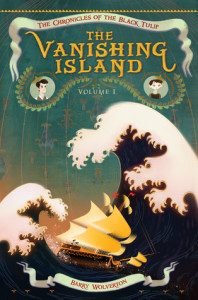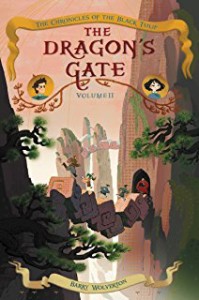Storytelling styles stay with you…
I have a vivid memory of the first time I read Treasure Island by Robert Louis Stevenson—my father read it aloud at our family evening “story hour.” The story held me in its grips—gritty, thrilling, slightly scary, and magnetic.
 The Vanishing Island, by Barry Wolverton—first in his series “The Chronicles of the Black Tulip”—reminded me a good deal of my Treasure Island memory. It has many of the same elements: a young boy eager for adventure, the gritty reality of life at sea, the terrible deeds committed when greedy appetites are whetted.
The Vanishing Island, by Barry Wolverton—first in his series “The Chronicles of the Black Tulip”—reminded me a good deal of my Treasure Island memory. It has many of the same elements: a young boy eager for adventure, the gritty reality of life at sea, the terrible deeds committed when greedy appetites are whetted.
Here’s the book summary:
“A young boy named Bren sets out on the high seas with a mysterious admiral to search for a legendary map that leads to an object of unspeakable power.”
By the way, my father read some of Treasure Island aloud to me again a couple of years ago, on a shared vacation in Florida. He can still do better pirate voices than I by a long shot! (Thanks, Dad, for the special memories!)
I liked The Vanishing Island enough to pick up its sequel, The Dragon’s Gate. Something interesting happens somewhere at the end of the first book, and definitely throughout the second book:
The storytelling style changes.
 The first book has the classic European storytelling style we are most accustomed to—as I said, reminiscent of Treasure Island with its tale of buccaneers and buried gold. Ancient Chinese tales take over the spine of the story in book two—its mysteries to be unraveled based on Chinese stories and myths.
The first book has the classic European storytelling style we are most accustomed to—as I said, reminiscent of Treasure Island with its tale of buccaneers and buried gold. Ancient Chinese tales take over the spine of the story in book two—its mysteries to be unraveled based on Chinese stories and myths.
As a reader, I found it fascinating how these differing storytelling styles feel different in my body—the rhythm of their language, the degree of symbolism and extrapolation, and so on. Maybe it is through my love of hearing stories aloud, but I believe each of us has a kind of recognition of storytelling styles—images in our heads, sounds, rhythms, feelings.
In The Dragon’s Gate the tale’s costar, “Mouse,” a young Chinese girl who’d been living as the ship’s boy in book one, takes center stage as she seeks her origins with Bren’s help.
In both books the characters are engaging, the worlds well drawn, pieces of real history woven into the fantastical with skill—making what is very difficult look easy! Thanks Barry Wolverton for this fun adventure series (historical, and fantasy adventure series!) I look forward to book three.
Happy Reading!